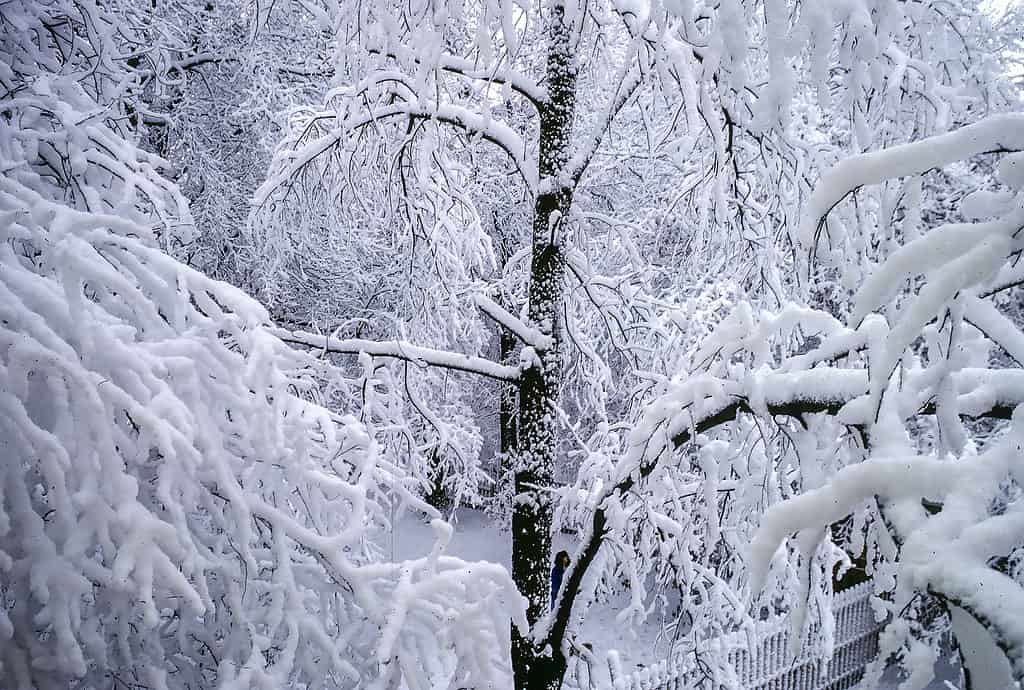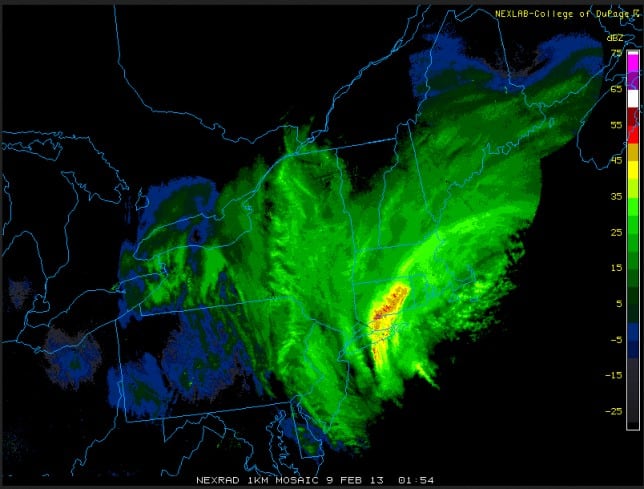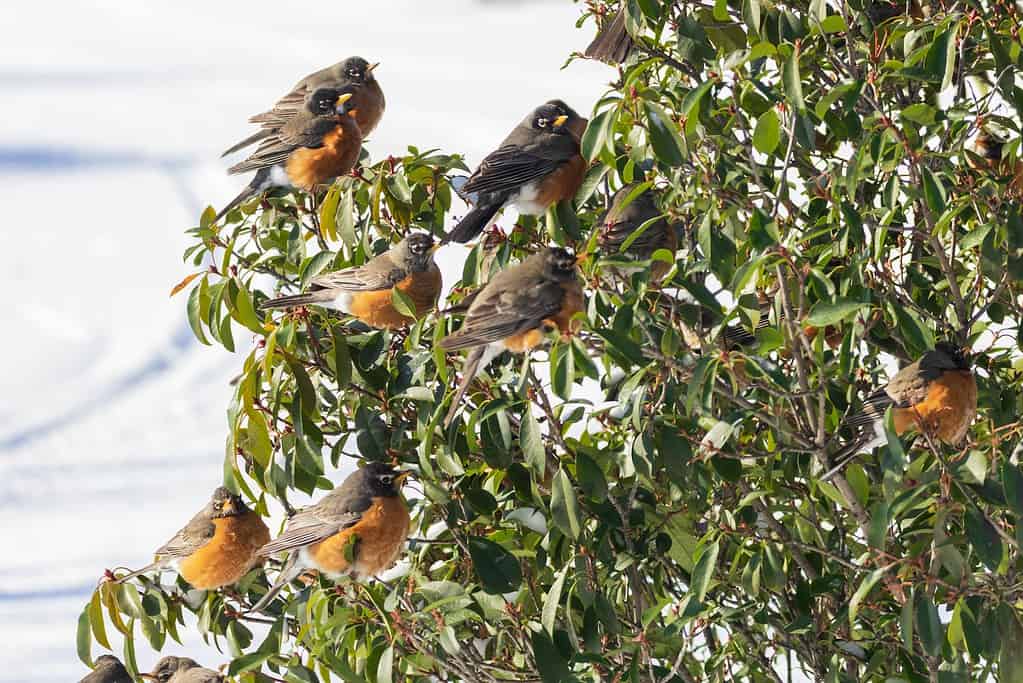You’ve probably heard the saying, “April showers, May flowers.” However, when we think of April showers, we don’t typically think of snow. It’s considered an anomaly when it snows in April, as April is part of the spring season.
However, weather can be very unpredictable in regions with a temperate climate. In these regions, even though it doesn’t usually happen, there can be snowstorms in April.
New England, including the state of Connecticut, is one such region. It’s known for very cold winters, and this winter weather will occasionally extend into the spring. But what was the biggest April snowstorm in Connecticut’s history? Read on to find out!

Weather can be very unpredictable in regions with a temperate climate.
©iStock.com/William Dummitt
What Was the Biggest April Snowstorm in Connecticut History?
The biggest snowstorm in Connecticut’s history took place on April 6, 1982. Even though April snowstorms are not unheard of in this state, this was one of the most severe blizzards that ever occurred.
Snowfall up to 14 inches, as well as winds up to 60 mph, were forecasted. The Farmer’s Almanac for 1982 had stated that the region was “in for a blow, plus more snow” for the month.
The storm came into New England from New Jersey. There was snow all over the state, between one and two feet in most areas. There were severe gusts of wind, some going up to 70 mph. The temperatures were unusually cold, especially for April. Thunder and lightning were present as well.
The city of Hartford received about 14.4 inches of snow, and Plainfield had a full two feet of snow!

Doppler radar image of a snowstorm over Connecticut in 2013.
©National Climatic Data Center, Public domain, via Wikimedia Commons – License
Impact of the Snowstorm
This snowstorm affected not only Connecticut but all of New England. Throughout New England, people were not prepared for the storm. Some communities had to take snow plows out of storage and drivers who didn’t have their snow tires ready.
There were multiple road accidents as well. The storm started during many people’s morning commute, and people had a very difficult time seeing the road.
Businesses closed early, schools were canceled, Massachusetts state workers had to go home early, and Rhode Island and Connecticut legislators took the day off. Many ski areas decided to reopen when they hadn’t planned to do so.
Airports in New England shut down as well, leaving many travelers stranded as they tried to travel home for Passover and Easter.

Airports in New England shut down as well, leaving many travelers stranded as they tried to travel home for Passover and Easter.
©Thomas Bethge/Shutterstock.com
What Is Typical April Weather in Connecticut?
Typical April temperatures in Connecticut are fairly moderate, usually between 41°F and 57°F. April is one of the rainiest months of the year, so people in the state can expect up to eight days of rain during the month. Snow is not uncommon during April, although snowstorms are fairly rare.
The Earliest Snowstorm in Connecticut
The earliest it has ever heavily snowed in Connecticut going into the winter season was October 5, 1987. On the prior day, the National Weather Service had been predicting “unseasonably cool weather with spotty snow showers.” However, what happened was a snowstorm that covered New York and New England, including Connecticut.
This storm cut off electricity to more than 300,000 people in the affected area. It also closed off roads and halted service at airports. In northwest Connecticut, there was an average of nine inches of snow on the ground. New Milford and Danbury received approximately three inches. About 75,000 residents of the state lost power.
How Late-Season Snowstorms Impact Wildlife in Connecticut
When the snow comes during unexpected times, animals may modify their regular habits. Animals have certain survival strategies for winter that they may have to retreat to when the snow comes later in the year. The following are just a few examples of animals in Connecticut that might show a response to a late-season snowstorm.

Robins also tend to form large flocks in cold weather, sometimes in the hundreds or even thousands.
©Martina Sliger/Shutterstock.com
Robins
Robins are the state bird of Connecticut. People see their presence as symbolic of the end of winter, even though these birds are present throughout the winter.
They do fly south for the winter, but it isn’t because they require warmer temperatures. Robins are capable of dealing with very cold temperatures, growing downy feathers that keep them warm. However, an unexpected snowstorm wouldn’t necessarily give them time to do this, so they may flee or retreat into hiding places.
Robins also tend to form large flocks in cold weather, sometimes in the hundreds or even thousands. They are also far less vocal in the winter, so this might happen during a late-season snowstorm as well.
If they stay, they are likely to change their diets. Instead of protein-rich invertebrates, such as earthworms, they might pursue berries and other winter fruits.
Overall, during cold weather, robins are much less noticeable to humans.
Black Bears
Black bears have a wide range in Connecticut, being particularly widespread in northwestern Connecticut. They are omnivores. Although they prey on deer, livestock, and small mammals, they also enjoy wetlands in the spring season because of the growing plants they can eat.
Typically, bears hibernate in winter dens during the winter. Males typically come out in mid-March, and females, who give birth during the winter, usually come out in mid-April. During late-season snowstorms, they may briefly retreat to their dens.
Timber Rattlesnakes
Timber rattlesnakes are very large venomous snakes in Connecticut, growing to be more than six feet long. During the winter, they create dens with other snakes on south-facing slopes amidst rocks.
Because snakes are cold-blooded, they are heavily affected by the temperature in their surroundings. Their optimal temperature range is between 60°F and 95°F. They can typically deal with colder temperatures for short times, but not for prolonged periods.
Snakes brumate during the winter, meaning they slow down their metabolism to conserve energy. They survive off of accumulated glycogen stores. Generally, they pick warm places to stay during this time. These can be caves, dens, or even man-made buildings. Timber rattlesnakes go back to the place where they were born to hibernate every year.
An unexpected snowstorm in April may cause a timber rattlesnake to retreat to their brumation spot for a short time.
The photo featured at the top of this post is © Michael Macsuga/Shutterstock.com
Thank you for reading! Have some feedback for us? Contact the AZ Animals editorial team.






